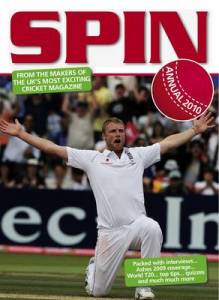103pp
New Holland
£9.99
First published in February 2005, a launch as well-timed as a Gower cover drive, SPIN magazine is entering the Christmas book market this year with its first “Annual”. According to the magazine’s website, this is “a Christmas book that will include the best of the material from our first 50 issues as well as exclusive material from the Ashes.”
Like the magazine, the book is popular rather than classical in style—Tufnell rather than Vaughan, if you will. There is lots of colour and big images. For £10, it looks good.
Just about everything of note that happened in 2009 is here: The Ashes, the IPL, the all-conquering England women’s team, the World 20/20 and the T20. But there is nothing at all on the County Championship.
Five of the nine entries in the four-page review of “This year’s biggest…” are for off the field events, including Lily Allen’s friendly chat with Jonathan Agnew on Test Match Special (the biggest “talking point”). “Sure there were some cringy moments,” admits Spin, “but no more than when the View from the Boundary slot includes A.N. Other actor struggling to remember some tiresome details from his trip to Headingley in 1958.” Quite. But I recall Miss Allen giggling a lot and not really saying much of interest to anybody, let alone TMS listeners.
Sir Allen Stanford crops up, too (biggest “hot potato”). The hypocrisy of so many people—notably the ECB and Kevin Pietersen—is exposed here deftly. The cricket authorities have done a good job in disassociating themselves from Stanford. It is spin doctoring that Alistair Campbell would be proud of.
The “What makes the greats great” explanations and analyses of players’ techniques are very good, as is a comparison of how much Flintoff and Harmison have bowled in comparison to Trueman, Larwood and Botham (nowhere near as much, actually). Spin has done an all-time ranking of England teams based on the ICC’s Test ranking methods that puts Peter May’s 1956 team top, four places ahead of Vaughan’s 2005 side. Who would ever have guessed that?
Another spread shows “How cricket became a batter’s game” (pp.62–63). Having recently read Jack Bannister and Don Oslear’s Tampering With Cricket, it becomes easier to be sympathetic towards bowlers supposedly “tampering” with the ball to make things happen when so much is weighed in the batsman’s favour.
There is also some fairly frothy stuff, like how your birthday might affect your chances of success as a professional cricketer. Most English-born/English-qualified players are born in September or October, apparently. And the quizzes can only be done once!
George Dobell’s suggestions for “10 ways to improve cricket” are all sound, but some would be easier to implement than others. Who exactly would be able to “Get the Indian Premier League Under Control” (p.25)?
In a book that is aimed at younger readers, it is pleasing to see that political correctness has been abandoned. Happily, the photograph of Harmison and Flintoff celebrating the 2005 Ashes win, with Fintoff holding a beer and cigar, has not been airbrushed. The famous Patrick Eagar image of Botham in the Headingley dressing room after his 149* always seems to lose the cigar whenever I see it in cricket magazines these days.
That other Headingley hero Bob Willis is not treated very sympathetically here but that is nothing new. He is rarely described in positive terms in the magazines and books that I read. (Perhaps I am reading the wrong ones?)
Jonathan Agnew says in one of his “First Person” sound bites, “The ECB wants people dressed up as bears, and wants to appeal to eight-year olds. But that’s wrong: you need to appeal to the parents—they’re the ones who bring the kids along ” (p.8). That, in a nutshell, is this book. It is cricket journalism dressed up as a bear. Spin Annual 2010 is a book for the young neophyte rather than the longstanding enthusiast and is none the worse for that.
Good post mate!! Keep ’em flowing!